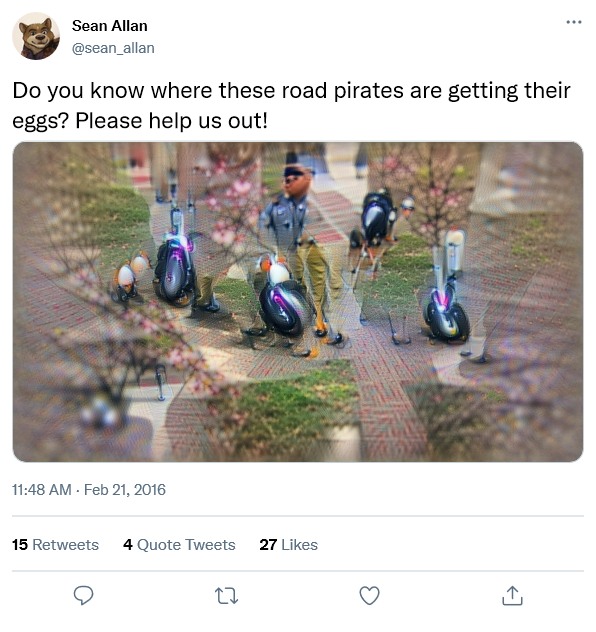One of the top ten lists of giraffe facts continued with a list of further articles on various subjects, one of which was ‘How the Egg-Scooter Works’. Curious about what an egg-scooter might precisely be, I enquired further with GPT-J.
In the resulting text, GPT-J mostly ignored the ‘egg’-bit (except for the fact that you can apparently replace it for just $15) and instead mostly talked about what looked like electric scooters in general, albeit a somewhat madcap version of them – or maybe it ultimately is the egg that is making all the difference here?
It's a bit of a shame that there is currently no easy way to generate a matching video for the included ‘Road pirate vs. electric bus on campus. #EggTaxi’ tweet, although thanks to Tweetgen and Aphantasia I can actually at least provide a still image.
The Top Ten facts about egg-scooters you'd never have guessed: 10. There are more than 400,000 egg-scooters in the United States. Egg-scooter shares have been increasing exponentially. In 2017, the number of scooters in the U.S. increased from 10,000 in 2016 to nearly 400,000. Altogether, there are about five million scooters in the U.S. At this rate, there will be over five million egg-scooters by 2020. 9. The scooters themselves are extremely sturdy. As the following video points out, the scooters are built to withstand rear-ending by buses and other heavy vehicles. After measuring the scooters, the length and steel frames all exceeded the legal requirements. That being said, when you put a $125 scooter on the roof of a vehicle, you're taking a huge risk. I prefer to take one off the roof whenever I can, but if I have to, I prefer a quick-deployment system. By the way, if you break your egg, you can always replace it. I recommend getting a $15 replacement egg. It's already preloaded with a plastic shell that you can throw away when it's no longer needed. Check out the video below to learn more about the egg-scooter. Road pirate vs. electric bus on campus. #EggTaxi pic.twitter.com/wg7mdG2Int — SIM School ⚡️ (@SimonEdU) February 15, 20168. The scooter can go extremely fast. The most exhilarating part of the egg-scooter is turning it on and racing it through a parking lot. Even though the speed is moderate, the acceleration is eye-popping, and you can drop the scooter from any height. When you're trying to get to class on time, you work hard to spend as little time as possible on the scooter. You cycle every morning and scooter in the evening, but who has time to break? The best thing about cycling is that it's free and it provides the freedom of traveling at a moderate speed, but it gives me the pleasure of a bullet-like speed when I need to. Since these scooters are so mundane, it's no surprise that people are using them to break the law. This often happens when there are lots of scooters. People will gang up on a single victim and deposit tens of thousands of dollars on them. This video shows a piece of illegal infrastructure on the campus of Simon Fraser University. It's not the first time that I've seen the university park scooters, and it won't be the last. I'm not waiting until the egg-scooters get banned, because I'll switch to riding a bike. There are lots of beautiful bike paths that go right to the doorsteps of my dorm. Unfortunately, it's the most common suggestion: stop using the scooter. If you're looking for some support, I wrote a detailed guide to using a bike to travel around campus. 7. You cannot take the egg-scooter on a highway. The simple reason why is because the highway is primarily for automobiles. There are ample sidewalks where you can get to your destination more quickly, and you can turn it on when you need to. Nevertheless, there's a hidden advantage to taking an egg-scooter on the highway. When you approach a rapid-transit station, the scooters issue a rapid-transit alert to all drivers. For example, on the #SkyTrain in Vancouver, the scooters will flash green for a tenth of a second to indicate that the train is approaching. When this sort of thing happens in a busy intersection, it's like a yellow light turning red. It forces people to slow down, thus giving the egg-scooter riders an advantage. Most of the time, the drivers are happy to share their space with the scooters because it means that the riders just keep moving. 6. It's a great way to talk to people. Egg-scooters are a great way to talk to people. Even if they're in a rush, they're open to having a conversation. I've heard some of the strangest stories from my scooter rides. It's been amazing to listen to people because of how different they are. I mostly use scooters to cycle to campus because I want to get a good workout. If I had to cycle around campus, it would take me hours and break my neck. Furthermore, I would be pushed around by another mode of transportation. The fact that the egg-scooter provides both a physical workout and a means to transport yourself from Point A to Point B is the reason why I've been using these things for years. 5. You can pay your taxes with scooters, too. In the United States, the federal government will tax you $330 per year. The highest amount that you can claim for a single trip is $2.75. There is no special tax for the scooter. In the province of British Columbia, the scooter riders pay the same amount that a bicycle rider pays ($5.05). This is why a lot of egg-scooter riders look like they're in a hurry when you see them. Since the Vancouver Public Transit Authority (VPSA) has been using a system called FarePort, Vancouver's transit users only have to pay a single fare from start to finish. This works great as long as you don't need to get off at the last stop on a route. Some people say that the scooters don't live up to their potential and that they're just a status symbol. I'd look at them another way. I think that they're an efficient way to get around a city. Transit systems are inefficient, and they require a tremendous amount of maintenance. This is not to say that bikes can't be maintained. The problem is that bikes require a lot of specialized equipment, and the average person doesn't have access to it. Bikes are impractical because one person cannot move as many people as a fleet of vehicles can. Furthermore, I would look at the scooters in the same light that the food stamp program looks at me. I think that you're better off using a food stamp to feed your family than to be forced to eat fast food. 4. They're useful for going between the UBC subway station and Devonshire. If you're an egg-scooter rider, you know that the UBC subway station is the best. It's a short walk from the doorsteps of the library. Unfortunately, there are not enough spots for a scooter to park, and you're stuck with the dilemma of having to either leave the scooter or the subway station. I like to use the UBC subway station as long as I can. Since the scooters are almost always full, I have more than enough space to put my bike on top of the scooter. When the scooters become full, you can either park your bike inside the scooter or bring your bike to the subway station. Most of the time, I'll park the bike at the station, but I really prefer to use the subway station. It's a two-minute walk to the art school, which has been a valuable asset for the UBC community. If I don't want to ride the egg-scooter, I like to bike. There are lots of interesting locations to go to, including the famous totem pole. If I don't have time to bike, I prefer to use the bus: it's a lot faster and it's always there when I need it.
The above text stops at that point due to once again hitting GPT-J’s character count limit. Having both some professional and personal interest in traffic light control, I wanted to know more about that strange ‘rapid-transit alert’, so instead trying to get the list to continue all the way to its end, I instead decided to generate some more text for fact no. 7.
[…] 7. You cannot take the egg-scooter on a highway. The simple reason why is because the highway is primarily for automobiles. There are ample sidewalks where you can get to your destination more quickly, and you can turn it on when you need to. Nevertheless, there's a hidden advantage to taking an egg-scooter on the highway. When you approach a rapid-transit station, the scooters issue a rapid-transit alert to all drivers. For example, on the #SkyTrain in Vancouver, the scooters will flash green for a tenth of a second to indicate that the train is approaching. When this sort of thing happens in a busy intersection, it's like a yellow light turning red. It forces people to slow down, thus giving the egg-scooter riders an advantage. It's a lot like the yellow-light advantage in Grand Theft Auto 5, only it's real life instead of a video game.
[…] "At Vancouver airport, the rider clearly flashes green indicating that they have a right-of-way for the approach to the airport," says David Biggs of SCI Robotics. "This can cause a traffic backup along the highway." The Metrolinx project plans to put light-up urban-speedways around the region. See map below. That's the good news. The bad news is that it won't be ready until at least 2020. In the meantime, you're going to have to wait until the end of this year.
[…] It's important to note that it's illegal to ride the egg-scooter on any public road in Japan. The enforcement is properly carried out. I have an arrangement with the Japanese police, so I can ride my scooter on the Japanese highway with them on my tail.
Even a ‘rapid-transit alert’ might not be enough to get you in time to your destination, but not to worry – GPT-J has another solution for that problem: A special elevator just for egg-scooters, where you can be just ‘inches away from the moving train’ and still be perfectly safe and arrive on time. Just don’t forget to always press your red button, and to wear some ear-protection for that deafining 20 dB-noise the elevator will be making.
[…] 7. You cannot take the egg-scooter on a highway. The simple reason why is because the highway is primarily for automobiles. There are ample sidewalks where you can get to your destination more quickly, and you can turn it on when you need to. Nevertheless, there's a hidden advantage to taking an egg-scooter on the highway. When you approach a rapid-transit station, the scooters issue a rapid-transit alert to all drivers. For example, on the #SkyTrain in Vancouver, the scooters will flash green for a tenth of a second to indicate that the train is approaching. When this sort of thing happens in a busy intersection, it's like a yellow light turning red. It forces people to slow down, thus giving the egg-scooter riders an advantage. However, sometimes you still can't make it on time. So, we provide a backup plan. The Egg-Scooter Elevator If you turn on the egg-scooter at a station, there's no guarantee that it will arrive at the station before the train does. But, if you hook it up to an elevator, then the speeders can ride the elevator right on up to the station. Once there, they will wait for the next train. It's like they rode the elevator right up to heaven. And, when the train arrives, they will press their red button, and the elevator will return them to Earth. And, they'll still have plenty of time to catch their train. Here are some of the benefits of an egg-scooter elevator: 1. No traffic jams When the scooter rider arrives, there will be no traffic jams. Because there will be no traffic. 2. No danger of being hit by the actual car The scooter rider will be inches away from a moving escalator. The car won't even come within an inch of them. 3. No danger of getting hit by the actual train The egg-scooter rider will also be inches away from the moving train. 4. It's safe The elevator will be moving at a slow pace, and there will be no danger of a collision. 5. It's easy When the train arrives, the scooter rider will be safe and sound. It's just a matter of pressing their red button. Here are some of the drawbacks: 1. It sounds weird The noise of the elevator will be heard by everyone, which will make it quite disconcerting. 2. It's loud The entire system will be at least 20 decibels. That's loud. 3. It's expensive The egg-scooter elevator will cost about $3,000. 4. It will attract attention The egg-scooter elevator will be much easier to spot than a normal scooter, and the people on the escalator will notice it. 5. It could get stuck The elevator could get stuck. However, life is full of unexpected problems, which means it's a small price to pay for a safe and comfortable ride. When the scooter rider arrives, the elevator will be at the station, and they will press their red button. Once the scooter rider gets out of the elevator, they will be able to board the train. However, the scooter rider will still have plenty of time to catch their train. Of course, the egg-scooter elevator is only for people who want to arrive at the station before the train. It's not for people who want to be left behind.
The ‘Road pirate vs. electric bus on campus. #EggTaxi’ incident sounded too intriguing, so I eventually decided to dig further into that. As before, the tweet ‘screenshots’ are courtesy of Tweetgen and Aphantasia. The ‘furry’ avatar images for the tweets have been taken from This Fursona Does Not Exist.
This one needed quite a bit of editing, though, i.e I didnʼt just simply fed it the prompt and hit ‘Continueʼ a few times and voilà – it took a few attempts until it followed up the initial tweet in the prompt with further tweets of its own and even following that I had to continue occasionally snipping off bits of the completion and backtracking a little in order to have GPT-J remain on topic instead of digressing towards egg-scooters (or even plain scooters) in general.
Soon after the first egg-scooters appeared in Vancouver, we got the infamous 'road pirate' incident on the SFU Campus. Here are some tweets documenting that event: Road pirate vs. electric bus on campus. #EggTaxi pic.twitter.com/wg7mdG2Int — SIM School ⚡️ (@SimonEdU) February 15, 2016Here’s video of road pirate incident @ SFU pic.twitter.com/DGXQrxFbc4 — Carlyle Hong (@HongPL2016) February 15, 2016 This is quite a mess, those silly egg-scooters are so cute 🐱🐱 and the mess they create is so huge! 😂😂😂 #SFU pic.twitter.com/GcN4GXGziS — 唐云山 (@tunyin) February 15, 2016So a bit of context to this, based on this tweet from @HongPL2016: […] road pirates emerge at SFU to ride carts laden with eggs across campus. @SFU management and law enforcement didn't catch anyone. pic.twitter.com/pjYsjwGZ5X — Carlyle Hong (@HongPL2016) February 15, 2016Here’s another account: Beware road pirates on campus! Hopefully parents recognize this and can stop them. @SFU pic.twitter.com/d6iFvbFhAz — Simon S (@7_Simons) February 14, 2016[update: it turns out that SFU has stated that the egg-scooters were stolen and e-bikes are not allowed on campus] Why should we care if the road pirate stuff is happening at SFU, on the surface it’s just people riding around with eggs on their scooter. But after watching that video, I’m pretty sure everyone knows what happened and might get caught themselves. Even a small amount of egg-lubrication can cause a lot of harm and damage. We’ve already seen a few videos of people getting hurt by egg-scooters. Who is causing this mess and vandalism? The story so far is that it’s a group of college students at SFU. And we need to ask a few questions: Where are they getting the eggs? The eggs don’t seem to be coming from the grocery store, so where are they getting them? And how do they manage to smuggle them through checkpoints? What is their motivation? Who is supplying them scooters and batteries? And how are the eggs being affixed to the scooters? I’m guessing they use the suction cups but there’s even a video of someone using a plastic bottle with like a pump thing to suck eggs onto the scooter. Here’s a video of the cops trying to get the scooter off of someone, the video shows that the eggs are still on there: Do you know where these road pirates are getting their eggs? Please help us out! pic.twitter.com/WT9W9IuOmL — Sean Allan (@sean_allan) February 21, 2016A blog for a group called the Egg Taxi Brigade confirmed that they are at SFU as well and that they “have been at SFU since last week” (according to the blog post) De-Eggs (SFU) — SFU Students for Social Justice (@DeEggsSfSfU) February 23, 2016Where are they getting the eggs? It’s not clear if a group is responsible for the egg-riding, but the blog also promises that they will return to SFU The group has tweeted that they are going to bring the scooters back to SFU and hope to get some students to help with de-egging them. (edited to add: the SFU students being egg-riding is a rumour and they are not affiliated with the “Egg Taxi Brigade” at SFU) Are they getting the eggs from a central source? There’s a group in Toronto called “Egg Rover Collective” which is actively involved in egg-laying and egg-smuggling. The group is the subject of a documentary called “Eggs for Sale” which I highly recommend watching.





